
About UsThe Numismatic Bibliomania Society is a non-profit organization promoting numismatic literature. For more information please see our web site at coinbooks.org SubscriptionsThose wishing to become new E-Sylum subscribers (or wishing to Unsubscribe) can go to the following web page link MembershipThere is a membership application available on the web site Membership Application To join, print the application and return it with your check to the address printed on the application. Membership is only $15 to addresses in the U.S., $20 for First Class mail, and $25 elsewhere. For those without web access, write to: David M. Sundman, Secretary/TreasurerNumismatic Bibliomania
Society AsylumFor Asylum mailing address changes and other membership questions, contact David at this email address: dsundman@LittletonCoin.com SubmissionsTo submit items for publication in The E-Sylum, just Reply to this message, or write to the Editor at this address: whomren@coinlibrary.com
BUY THE BOOK BEFORE THE COINYou won't regret it! |
- WAYNE'S WORDS: THE E-SYLUM MARCH 11, 2012
- ANNOUNCEMENTS REGARDING LAKE BOOKS SALES #110, #111
- NEW BOOK: THE 2013 GUIDE BOOK OF UNITED STATES COINS
- BOOK REVIEW: LES MONNAIES ROYALES FRANÇAISES 1610-1792, 4TH ED.
- BOOK REVIEW: THE BANKNOTE BOOK
- BOOK ON SPINTRIAE: LE TESSERE EROTICHE ROMANE
- NUMISMATIC LITERATURE IN THE CAPPING LIBERTY EXHIBIT
- HANK SPANGENBERGER 1934 - 2012
- R.C. DAVIS, DRUG PUSHER TO THE MINT?
- NUMISMATIC VOCABULARY: BRONZE VS BRASS
- QUERY: PROFESSOR STEVEN R. YOUNG SOUGHT
- QUERY: A SILVER AMULET
- NOTES FROM E-SYLUM READERS: MARCH 11, 2012
- QUERY: INFORMATION ON CHAPMAN'S FLYING DRAGON DOLLAR SOUGHT
- MORE ON THE FLEA MARKET CONTINENTAL DOLLAR
- QUICK QUIZ: WHO ARE THESE 1930S NUMISMATISTS?
- MANHATTAN BEACH NUMISMATIC CONNECTIONS
- THE 1933 DOUBLE EAGLE WORLD TOUR MOVES TO IRELAND
- PAKISTANI GROUPS COUNTERFEITING INDIAN BANKNOTES
- QUERY: BRONX COIN CLUB MEDAL INFORMATION SOUGHT
- NAPOLEON III, THE FRENCH VAMPIRE
- PAKISTANI BANKNOTE FOUND IN NEW PAIR OF JEANS
- HOW A BELLY DANCER FLIPS COINS
- FEATURED WEB PAGE: LE MONETE SATIRICHE
WAYNE'S WORDS: THE E-SYLUM MARCH 11, 2012

New members this week include D. G. Gibbons and Benjamin D. Gastfriend. Welcome aboard! We have 1,518 email subscribers, plus 173 followers on Facebook.
This week we open with a note from Fred Lake, a new Redbook edition, and two book reviews (OK, one of them is a web site review).
Other topics include numismatic literature in the Capping Liberty exhibit at Princeton, Bronze vs Brass, the Flying Dragon Dollar, Pakistani counterfeiting, and satirical medals.
To learn more about Hank Spangenberger, R.C. Davis, Roman "brothel tokens", a new country in the latest edition of Krause's 19th century world coin catalogue, Napoleon the French Vampire, and how a belly dancer flips a coin, read on. Have a great week, everyone!
Wayne Homren
(whomren@gmail.com)
Numismatic Bibliomania Society
ANNOUNCEMENTS REGARDING LAKE BOOKS SALES #110, #111
The prices realized list for our sale #110 featuring Part One of the John R. (J.R.) Frankenfield library is now available for viewing on our web site at http://www.lakebooks.com/current.html
Lots that contained personalized presentation copies of books and catalogs commanded premium prices with a large number of bidders on each. Results were strong and reflected the quality of this type of material. Overall the sale generated strong participation by our subscribers with many lots bringing bids from dozens of bidders.
Our next sale will be held in May, 2012 and will feature Part Two of the Frankenfield library and also will include material from other consignors who have helped to make this coming sale a complete picture of what is available in reference works from the various facets of the numismatic experience.
Many thanks to our bidders and consignors who have helped to make our sales a continuing success since 1989.
Lake Books
6822 22nd Ave. N.
St. Petersburg, FL 33710
727-343-8055 Fax 727-345-3750
NEW BOOK: THE 2013 GUIDE BOOK OF UNITED STATES COINS
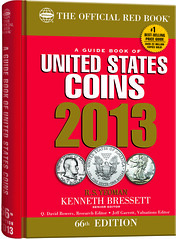 The new 2013 (66th) edition of the Guide Book of United States Coins (known to collectors as the "Red Book") is 16 pages longer than the 2012 edition. At 448 pages, it includes many new features, plus more than 300 additional or updated color photographs. The new edition, debuting in four different formats March 22 at the Whitman Baltimore Coin & Collectibles Expo, is available for preorder online (including at Whitman.com) and will be in bookstores and hobby shops nationwide April 10.
The new 2013 (66th) edition of the Guide Book of United States Coins (known to collectors as the "Red Book") is 16 pages longer than the 2012 edition. At 448 pages, it includes many new features, plus more than 300 additional or updated color photographs. The new edition, debuting in four different formats March 22 at the Whitman Baltimore Coin & Collectibles Expo, is available for preorder online (including at Whitman.com) and will be in bookstores and hobby shops nationwide April 10.
The 2013 edition has 1,974 full-color images. It prices 7,045 entries in up to 9 grades each, with more than 32,000 total valuations. More pages have been added to the sections on pre-federal coinage, silver and related dollars, commemoratives, and Proof and Mint sets.
"Readers will scarcely recognize the 2013 Red Book when they see its extensive upgrades and additions," said longtime senior editor Kenneth Bressett. "It is not 'your father's old pricing catalog.' Changes have been made throughout to keep it up to date with the outpouring of new and innovative issues from the United States Mint. That alone is no small consideration for it includes an assortment of more than $23,000 worth of new Mint products. And, of course, the same amount of attention is given to the older coins that extend back to 1616."
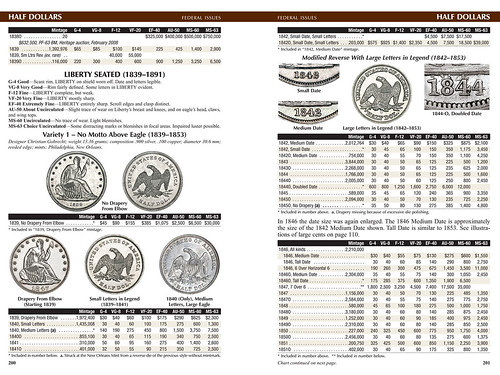
Collectors will benefit from auction records provided for significant recent sales. "More than 160 auction results are included within the chart listings," said Valuations Editor Jeff Garrett. "These combine with the retail valuations to paint an accurate picture of the high-end rare-coin market. In addition, the appendix on the Top 250 Auction Prices for U.S. Coins has been fully updated. Since the last edition, three more coins have broken the $1 million mark, for a total of 45."
Research Editor Q. David Bowers, commenting on the book's continuing popularity (more than 22 million copies have been sold since 1946), noted that "Even in the Internet age, the Red Book remains solidly the collector's best and first choice for instant information."
Due to popular demand and strong interest in the bullion markets, a special appendix on the Mint's American Arts gold bullion medals (1980-1984) has been added.
Also new is an illustrated essay on "Coin Collecting Yesterday and Today," describing the coin market and hobby going back to the mid-1940s, when the Red Book debuted.
Commentary on today's rare-coin market has been expanded in the introduction, with sections on third-party grading and authentication.
Mintage figures for all circulating coins and commemoratives have been updated as currently as possible with official data from the U.S. Mint.
"Two exciting new features have been added to the pre-federal, or colonial, coin section," said Kenneth Bressett. "One is an expanded and carefully organized coverage of the copper coins of New Jersey, and the other is a more extensive listing of the enigmatic pieces commonly known as Machin's Mills coins." Appendix B, "Collectible Red and Blue Books," has also been expanded with more details. Coverage of recent collectible Red Books includes the 2012 American Numismatic Association special edition, currently valued at $100 in New condition.
In perhaps a good measure of the health of the hobby, the listings in the Red Book's numismatic bibliography include more than 20 standard references published in the past five years.
About the Guide Book of United States Coins
A Guide Book of United States Coins is the world's most popular annual retail price guide for U.S. coins, tokens, and other numismatic items. More than 22 million copies have been purchased since 1946, making it one of the best-selling nonfiction titles in the history of U.S. publishing.
For the 66th edition, more than 140 professional coin dealers, scholars, and other numismatic experts contributed their knowledge under the direction of Editor Kenneth Bressett, Valuations Editor Jeff Garrett, and Research Editor Q. David Bowers.
 The 66th edition of the Red Book is available in April 2012, online and at bookstores and hobby shops nationwide. In addition
to offering a Large Print Edition and several formats of the regular edition, Whitman Publishing is also taking pre-orders
for the leather-bound Limited Edition (1,000 copies autographed by Bressett). For more information and to order, the Whitman
web site is www.Whitman.com. The publisher is offering free shipping on every order placed online that includes a 66th-edition
Red Book, through April 17.
The 66th edition of the Red Book is available in April 2012, online and at bookstores and hobby shops nationwide. In addition
to offering a Large Print Edition and several formats of the regular edition, Whitman Publishing is also taking pre-orders
for the leather-bound Limited Edition (1,000 copies autographed by Bressett). For more information and to order, the Whitman
web site is www.Whitman.com. The publisher is offering free shipping on every order placed online that includes a 66th-edition
Red Book, through April 17.
448 pages
Full color
By R.S. Yeoman; senior editor Kenneth Bressett; research editor Q. David Bowers;
valuations editor Jeff Garrett
$14.95 spiralbound
$16.95 hardcover
$19.95 spiralbound hardcover
$29.95 Large Print Edition
$69.95 leather-bound Limited Edition (1,000 copies)
BOOK REVIEW: LES MONNAIES ROYALES FRANÇAISES 1610-1792, 4TH ED.
 Pastrone, Francesco. Les monnaies royales françaises 1610-1792, 4th ed. Monaco: Éditions Victor Gadoury, 2012. French language. Hardbound with colour photos, 508 pages. ISBN 978-2906602403. Price: 49 euro.
Pastrone, Francesco. Les monnaies royales françaises 1610-1792, 4th ed. Monaco: Éditions Victor Gadoury, 2012. French language. Hardbound with colour photos, 508 pages. ISBN 978-2906602403. Price: 49 euro.
Éditions Victor Gadoury recently launched the fourth edition of its Les monnaies royales françaises 1610-1712 (Royal Coins of France, 1610-1792), commonly referred to as the "White Gadoury," a well respected publication first published in 1978 and written by the late Victor Gadoury himself.
This new edition of what I would call "The Four Louis" (since it covers the coinage of kings Louis XIII, XIV, XV, and XVI) has benefited from considerable research on the subject over the past few decades. Indeed, Gadoury's text has been updated with the research of some twenty renowned French numismatists.
The coins are presented by reign, from the smallest denomination to the largest. A list of all mint marks is at the beginning of each reign. One of the biggest changes introduced in this edition has been the discard of mintage figures that have been deemed inconsequential since many of the pieces struck by these kings were later reformed. A rarity scale has thus taken their place: C (common), R (101-500 known), R2 (51-100), R3 (11-50), R4 (5-10), and R5 (less than 5 known).
Another change is the presentation itself. Each coin type is presented with spectacular colour images that are accompanied by the following data: reference number, fineness, official weight, diameter range, edge, engraver, and some notes. The values for three conditions are presented in a table. These conditions are: TB (Très Beau = Fine), TTB (Très très beau = Very Fine), and SUP (Superbe = Extremely Fine). Also included in the table is the date, mint, rarity, and whether the known pieces are reformations (identified by the use of "rf") or struck on new planchets (identified by "fn").

All in all, a superb book well worth the 49-euro price for those that specialized in these series. My rating: 5/5. It is available directly from the publisher at www.gadoury.com/fra/libro-134-monnaies-royales-francaises-2012.htm .
BOOK REVIEW: THE BANKNOTE BOOK
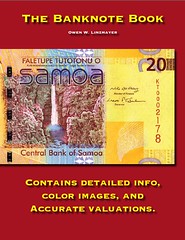 Linzmayer, Owen W. The Banknote Book.
www.banknotebook.com
Linzmayer, Owen W. The Banknote Book.
www.banknotebook.com
For the past few years, Owen Linzmayer, a past editor of the IBNS Journal, has been working on an electronic book called The Banknote Book. Like most of us, Owen had been using Krause's Standard Catalog of World Paper Money (SCWPM) and found it wanting in some areas, particularly when it came to images. That is when he decided to tackle the huge undertaking of putting together a new world catalogue that would meet the needs of bank-note collectors, beginners and advanced alike.
He has been doing so one step at a time, or more precisely, one chapter (country) at a time. Thus far, he has completed 111 chapters, that is over 1000 pages containing more than 1400 notes and 8300 types and varieties. Each chapter of The Banknote Book includes detailed descriptions and background information, full-colour images, and accurate valuations, as well as:
- Sharp colour images of note's front and back without overlap
- Face value or date of demonetization if no longer legal tender
- Specific identification of all vignette elements
- Security features described in full
- Printer imprint reproduced exactly as on note
- Each date/signature variety is assigned an individual sub-number
- Variety checkboxes for tracking your collection and want list
- Red stars highlight notes missing in the SCWPM
- Date reproduced exactly as on note
- Precise date of introduction noted when known
- Replacement note information
- Signature tables, often with names and terms of service
- Background information for historical and cultural context
- Details magnified to distinguish between note varieties
- Bibliographic sources listed for further research
Since it is an electronic book available for download from the website, collectors can buy the chapters individually. The price varies according to the size of the chapter.
My rating: 5/5, but you don't have to take my word for it, download the free sample from the web site, you'll see.
For more information about Moneta and the Ottawa Numismatic Society, see: ons-sno.ca
BOOK ON SPINTRIAE: LE TESSERE EROTICHE ROMANE
 The long running discussion on the subject of Roman spintriae sent me digging through boxes of part of my library that hasn't been unpacked since my last move... ten years ago. I don't believe anyone brought up this little brown book.
The long running discussion on the subject of Roman spintriae sent me digging through boxes of part of my library that hasn't been unpacked since my last move... ten years ago. I don't believe anyone brought up this little brown book.
About 28-30 years ago, a dealer friend talked me into purchasing sight unseen a catalog of, as he described, Roman brothel tokens. He needed to order five copies to receive a discount so reluctantly I let my arm be twisted. I do not recall for certain whom the dealer ordering the books was but the circumstance immediately brings David Schenkman to mind.
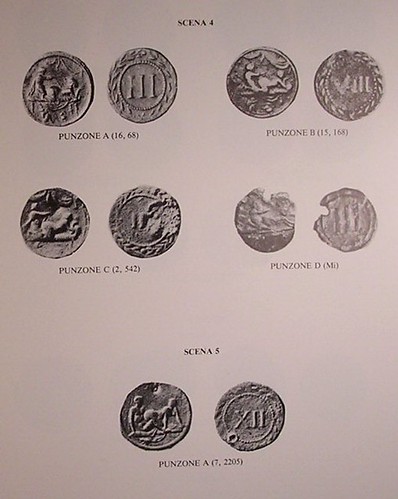
In any case, I acquired this approximately octavo sized 1981 dated glossy 44 page catalog, skipped the numerous pages of Italian text (I don't read Italian), read the summary (I do somewhat better with English), looked at the photographs and then put it on a top shelf until I needed it for an attribution. Needless to say I haven't opened it in about 28 years or so. At least now after 28 years I can justify the purchase in the name of edification.
To read the earlier E-Sylum article, see: SPINTRIAE ARE NO BROTHEL TOKENS (www.coinbooks.org/esylum_v15n05a09.html)
NUMISMATIC LITERATURE IN THE CAPPING LIBERTY EXHIBIT
I only had about a half hour available to see this exhibit, so can't write a fair review of it, but noted the following displayed items of particular interest to students of numismatic literature (all right then, I'm being pedantic, make that bibliomaniacs):
Henry Phillips's personal copy of his two volume treatise, Historical Sketches of the Paper Currency of the American Colonies Prior to the Adoption of the Federal Constitution (Roxbury, MA., W. Elliot Woodward's Historical Series, 1865), interleaved, with actual specimens of colonial currency mounted in the interleaves; the books on exhibit are opened to the New Jersey and Continental Currency sections.
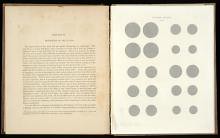 A copy of Jacob R. Eckfeldt and William E. DuBois's Manual of Gold and Silver Coins of All Nations Struck within the Past Century (Philadelphia, Office of the Mint, 1842), opened to Plate II (United States -- silver), alongside an exhibit of coins from the University's special collections matching the coins illustrated on the plate. The images on these coins include the familiar allegories of Liberty wearing the pileus and the seated Liberty holding the cap on a pole.
A copy of Jacob R. Eckfeldt and William E. DuBois's Manual of Gold and Silver Coins of All Nations Struck within the Past Century (Philadelphia, Office of the Mint, 1842), opened to Plate II (United States -- silver), alongside an exhibit of coins from the University's special collections matching the coins illustrated on the plate. The images on these coins include the familiar allegories of Liberty wearing the pileus and the seated Liberty holding the cap on a pole.
A copy of the only book written by the author of the Declaration of Independence, Thomas Jefferson, from the University's rare book collection, signed by Jefferson with annotations in his own hand. Jefferson, along with Benjamin Franklin and George Washington, had much to do with the choice of images to be placed on our coins and currency, and sections of the exhibit are devoted to the numismatic legacy of these men.
The exhibit, drawn entirely from the University's holdings, will remain open through July 8. There will be curatorial tours led by Stahl at 2:30 p.m. on March 25, May 6 and May 31. The May 6 tour will be followed by a lecture by Louis Jordan of the University of Notre Dame on the topic "Transformations in Numismatic Iconography during the American Revolution".
To read the earlier E-Sylum article, see: CAPPING LIBERTY: NUMISMATIC ICONOGRAPHY FOR THE NEW AMERICAN REPUBLIC (www.coinbooks.org/esylum_v15n09a05.html)

HANK SPANGENBERGER 1934 - 2012
Heath MacAlpine writes:
Long time Dayton-Kettering Coin Club member and nationally prominent numismatist Hank Spangenberger has died at age 79. His obituary appeared in this morning's Dayton Daily News.
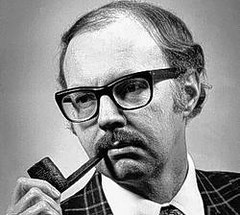 Henry "Hank" G. Age 79 of Kettering, OH, passed away on March 7, 2012. Hank considered himself a collector of anything unusual, interesting or rare with the professional title of Numismatist. His interest in coins surfaced as a youngster when he joined the Dayton Coin Club in 1947 and he continued in this career for the remainder of his life.
Henry "Hank" G. Age 79 of Kettering, OH, passed away on March 7, 2012. Hank considered himself a collector of anything unusual, interesting or rare with the professional title of Numismatist. His interest in coins surfaced as a youngster when he joined the Dayton Coin Club in 1947 and he continued in this career for the remainder of his life.
He was a lifetime member of the American Numismatic Association, the largest organization of coin collectors in the world and a lifetime member of the Dayton-Kettering Coin Club. He was also past Historian for the ANA and received the "Writer's Award" from the Numismatic Literary Guild. He was also member of The Rittenhouse Society and won the Numismatic Ambassador's Award. President Ford appointed Spangenberger to the 1976 Assay Commission, the first Daytonian to receive this honor in the 184 year history of the commission.
He was a 1950 graduate of Fairview High School of Dayton, OH and 1958 graduate of Bowling Green State University where he was a member of Sigma Chi fraternity. He was a Korean War Veteran.
He was preceded in death by his wife of nearly thirty years, Marcia Gastineau. He is survived by his brother John Spangenberger; John's son Richard and daughter Sue Frisbee; Henry's sons: Douglas, Matthew, and Gregory; his daughter, Heather and son-in-law Tom Murray. Their children, Meghan, Jason, and Jacob, and by his long time friend and companion Phyllis Thompson.
A memorial service will be held on Friday, March 16 at 2pm at St. Paul's Episcopal Church, 33 W. Dixon. Oakwood, OH, 45419. In lieu of flowers, donations can be made to the ANA's YN Programs, 818 North Cascade Ave, Colorado Springs, CO 80903. Arrangements in care of SWART & WOLFE FUNERAL HOME, West Carrollton.
To read the complete article, see:
Henry Spangenberger
(www.legacy.com/obituaries/dayton/obituary.aspx?
page=lifestory&pid=156402942)
Larry Dziubek forwarded this note from Jerry Schaeper Jr., who writes:
I've known Hank since the late 1970's. He was very much a part of the numismatic and exonumia scene in years past. He ran the IKO-TAMS annual show auction in the early years, and had a table there. One of his trademark practices at our show was to dump a full bucket of loose tokens and medals into a display case, and offer the group for $1,000. He amassed a lot of exonumia from many years at his shop, and threw pieces aside that he didn't have an immediate need for. I bought more than one such bucket full from him...
R.C. DAVIS, DRUG PUSHER TO THE MINT?
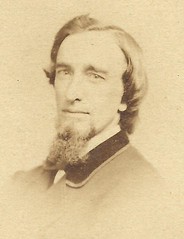 Regarding Pete Smith's follow-up question about pharmacist-collector Robert Coulton Davis,
Barbara Barbara Bonous-Smit writes:
Regarding Pete Smith's follow-up question about pharmacist-collector Robert Coulton Davis,
Barbara Barbara Bonous-Smit writes:
I believe that Breen got the information about Robert Coulton Davis from his obituary, which was published in the American Journal of Numismatics 1888, p. 47. (Available online via Google Books at:
An obituary of Davis titled :Death of Robert Coulton Davis" was also published in the New York Times 26 August 1888, p. 2.
Very brief information at:
431 BIOGRAPHICAL SKETCHES OF COPPER NUMISMATIC PERSONALITIES (http://www.1794largecents.com/1794/bios.htm)
Robert Coulton Davis' "Pattern and Experimental Issues of the United States Mint" was published in the Coin Collector's Journal, 1885.
Dave Bowers writes:
The Breen tale about R.C. Davis giving drugs to Mint officials is a classic Breenism. In the 1870s and 1880s anyone at the Mint or anywhere else could have bought opium at a drugstore without prescription. It was not until the 1906 Pure Food and Drugs Act (effective January 1, 1907) that narcotics were restricted. Mrs. Winslow's Soothing Syrup for babies, for example, popular in the 19th century, had opium as a base and was available over the counter.
To read the earlier E-Sylum article, see: QUIZ ANSWER: ROBERT COULTON DAVIS (www.coinbooks.org/esylum_v15n10a08.html)
To read the complete article, see: QUIZ ANSWER: ROBERT COULTON DAVIS (www.coinbooks.org/esylum_v15n10a08.html)
NUMISMATIC VOCABULARY: BRONZE VS BRASS
 The Manhattan Beach California struck piece mentioned in the last two issues of E-Sylum is an attractive numismatic item. It is called a "coin" which does not bother me -- it is not a coin by numismatic definitions because it does not bear a denomination -- but it is struck in a coining press so the term can be considered appropriate because it squeaks in under the umbrella of "coining."
The Manhattan Beach California struck piece mentioned in the last two issues of E-Sylum is an attractive numismatic item. It is called a "coin" which does not bother me -- it is not a coin by numismatic definitions because it does not bear a denomination -- but it is struck in a coining press so the term can be considered appropriate because it squeaks in under the umbrella of "coining."
What does bother me, however, is calling the bronze version "brass." Granted, the boundary line between bronze and brass is not finite. Both are alloys of copper. I once wrote that copper is the word's most popular coinage metal. Mixed with a portion of zinc and or tin it is bronze, it is alloyed in coinage nickel, with silver it forms sterling or .900 fine silver. Copper is even alloyed with gold to lessen its karat content.
So what is the difference between bronze and brass? If the zinc is less than 10% it is bronze. But numismatists are not satisfied with the term at this precise formulation.
For numismatists -- who can best describe an item by inspection -- the term is determined by color. If the piece is brown it is bronze. If it is golden yellow it is brass. But the color of the metal alloy doesn't change until the zinc content is above 15%, or as expressed in the metalworking trades, copper 850 zinc 150. This adds to 1000, but sometimes expressed .850 and .150 to add to 1 -- the total amount.
Technically that area between 10% zinc and 15% zinc alloyed with 90% to 85% copper is called red brass. At zinc 160 copper 840, one percent more zinc you find a solid yellow-brass color. This continues as the amount of zinc increases. However red brass is not permanent. Like a freshly struck U.S. cent it is copper-red color that after about six month's time harsh exposure or much handling in circulation has turned brown. It is the copper content that causes the color change.
All of these copper alloys have been used for coins under a variety of terms for the various compositions. These include French bronze, tombac, Dutch metal, Mannheim gold, copper-nickel, and ultimately oroide or goldene. The latter is at 33% zinc content with an obvious brass-gold color.
In medal rank, brass is beneath bronze: Gold, Silver, Bronze, Brass. Thus bronze is a tad bit more éclat with a higher esteem. respect, repute, it is more desirable.
This wide diversity of zinc content in copper alloys also has another popular use -- foundry casting of statues. Statues can be made from the same metal as copper, bronze or brass alloys used for coins. The standard alloy for bronze casting is 900 copper, 030 zinc, 070 tin. Makes the best for casting and the patina afterwards for both indoor and outdoor statues.
When the zinc is entirely replaced by tin it can be used for bell manufacture. However, after centuries of bell manufacture, bell foundries like to get as close as possible to 78 to 80% copper and replacing the zinc entirely with tin content at 20 to 22%. I guess this is best for the sound quality.
Impurities can be found in all these compositions by spectrographic analysis. Other metal elements are often found in these alloys. A trace of phosphor is sometimes beneficial (up to 0.2%). A trace of lead is undesirable. However, even lead in a copper-zinc composition is permissible for making cartridge casings for ammunition. Since these encase lead projectiles, lead will be found in spent cartridges, particularly when reused over and over, or melted and made into new cartridges.
We could not have all the world's coins if we did not have copper. The alloys of copper for numismatic items have been called many things. But it's okay to call brown coins or medals "bronze" and golden yellow coins and medals "brass." One variety of the Manhattan Beach Centennial Medal is brown. Let's call it bronze.
The bronze medal is illustrated at: manhattanbeachcentennialcoin.com .
To read the earlier E-Sylum article, see: MANHATTAN BEACH CENTENNIAL MEDALS ISSUED (www.coinbooks.org/esylum_v15n09a17.html)
BRONX COIN CLUB MEDALS WANTED
Contact William Marquis at WMarq69070@aol.com
with description and price.
QUERY: PROFESSOR STEVEN R. YOUNG SOUGHT
Howard Daniel writes:I have been digging into boxes in my "black hole" looking for anything related to Cambodian numismatics. I found a 12-page paper with the title of A Trial Listing of the Early Coinage of Cambodia 1580-1902 by Professor Steven R. Young. It is photocopied on the back of paper from the Cash Coin Connection issue of August 15, 1992, so I am thinking it was written at about the same time, but it could have been years later.
If any reader knows Professor Young, please have him contact me at HADaniel3@MSN.com. I would very much like to know if he is still interested in Cambodian numismatics, and if he has learned more about it since he wrote the paper.
QUERY: A SILVER AMULET
Dick Grinolds writes:
You published a medal from the Stacks Americana auction ("Some Stacks-Bowers January 2012 Americana Sale Lots) in the 1-22-12 issue which matched a similar medal in the research box on my desk, one that I purchased at the ANA in Chicago last August.
My example is silver, 40mm diameter but only 41.3 grams in weight; other than the composition and the attached loop, it is identical to the gold specimen in the sale. Of course the actual specs on my silver medal don't match the weight noted on the gold piece. Any further information on the medal or Mr. Wiss would be appreciated.
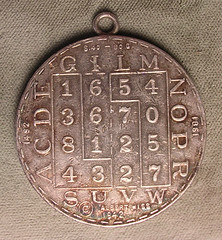

Lot #6308. Mysterious Gold Medal Issued By Albert Wiss


To read the earlier E-Sylum article, see: SOME STACKS-BOWERS JANUARY 2012 AMERICANA SALE LOTS (www.coinbooks.org/esylum_v15n04a17.html)
NOTES FROM E-SYLUM READERS: MARCH 11, 2012
Paul Bosco Typo Joe Boling submitted notes on several items this week. First up:
I assume Paul Sosco was really Paul Bosco in this issue.
To read the earlier E-Sylum article, see: NOTES FROM E-SYLUM READERS: MARCH 4, 2012 (www.coinbooks.org/esylum_v15n10a10.html)
More on Lee Shin Song Joe Boling writes:
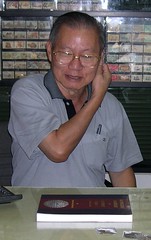 As another comment on the passing of Thai dealer Lee Shin Song - when Howard Daniel was preparing his collection to go to Bangkok, he asked Mr Lee whether he wanted the counterfeit notes, which Howard had going back almost a century. Mr Lee said he had no market for them there, and Howard could dispose of them elsewhere if he desired. That meant that they now are in the Boling collection for teaching counterfeit detection. I never met Mr Lee, but I am grateful for his generosity.
As another comment on the passing of Thai dealer Lee Shin Song - when Howard Daniel was preparing his collection to go to Bangkok, he asked Mr Lee whether he wanted the counterfeit notes, which Howard had going back almost a century. Mr Lee said he had no market for them there, and Howard could dispose of them elsewhere if he desired. That meant that they now are in the Boling collection for teaching counterfeit detection. I never met Mr Lee, but I am grateful for his generosity.
To read the earlier E-Sylum article, see: THAI NUMISMATIST LEE SHIN SONG (www.coinbooks.org/esylum_v15n10a07.html)
Tax Deductibility of Commemorative Surcharges Joe Boling writes:
Regarding the tax deductibility of surcharges on modern commemorative coins, when I inquired about that a few years ago I was told that the enabling legislation specifically prohibits using these surcharges as tax deductions. I presume there is piece of boilerplate that gets inserted into every coin bill to cover this topic. As Anne said, Congress makes the laws. Take it up with your legislators.
To read the earlier E-Sylum article, see: QUERY: WHY AREN'T COMMEMORATIVE COIN SURCHARGES TAX-DEDUCTIBLE? (www.coinbooks.org/esylum_v15n10a11.html)
Counterfeit Dollar Coins Joe Boling writes:
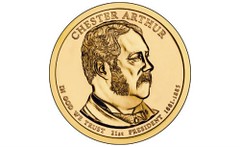 The counterfeit dollar coins are not being made to use here - they are going to places like Ecuador that are using US dollars as national currency. In my opinion, the threat of counterfeiting metallic dollars is minuscule (and insignificant) compared to the threat from counterfeiting $10 and $20 notes on 2% of teenager's desks.
The counterfeit dollar coins are not being made to use here - they are going to places like Ecuador that are using US dollars as national currency. In my opinion, the threat of counterfeiting metallic dollars is minuscule (and insignificant) compared to the threat from counterfeiting $10 and $20 notes on 2% of teenager's desks.
Digital copies of US notes circulate freely until they hit the Fed and are sorted out - way after the maker has turned her profit. And then there are the high-quality lithographed C-notes coming from South America and the supernotes coming from North Korea and other points undisclosed. Your article mentioned the spread of counterfeit coins in Europe - I am sure that fake 50-euro notes make up a far larger pool of boodle than the coins can approach.
To read the earlier E-Sylum article, see: ARTICLE EXPLORES THREAT OF DOLLAR COIN COUNTERFEITING (www.coinbooks.org/esylum_v15n10a16.html)
Smuggling Ancient Coins Arthur Shippee writes:
Here's an interesting post on the smuggling of ancient coins.
To read the complete article, see:
Greek Antiquities Bust and the No-Questions-Asked Antiquities Trade
(paul-barford.blogspot.com/2012/03/more-arrested
-in-greek-antiquities-bust.html)
American to Get CBE Medal Gar Travis writes:
An American will become an Honorary Commander of the Order of the British Empire (CBE).
One of Britain's highest honors will be bestowed on William Kelso, Historic Jamestowne's director of archaeology.
Kelso will become Honorary Commander of the Order of the British Empire (CBE), an honor awarded for especially inventive and celebrated contributions to the recipient's field, according to a press release from Colonial Williamsburg.
Kelso led archaeologists in the discovery of over a million artifacts on Jamestown Island, including the location of the original 1607 fort that had been thought lost to the James River. The site includes the original fort, the later statehouse and other buildings. The most recent find is a church dating back to 1608 and was the wedding site of Chief Powhatan's daughter, Pocahontas, and John Rolfe.
To read the complete article, see:
Jamestown Archaeologist to Receive British Top Honor
(wydaily.com/local-news/8534-jamestown-archaeologist
-to-receive-british-top-honor.html)
The Smithsonian's Trove of Numismatic Rarities Regarding the current "world tour" of a 1933 double eagle from the National Numismatic Collection, Gene Brandenburg writes:
After hiring her son Alex to work in my coin store in Alexandria, Elvira ("Elsie") Clain Stefanelli invited me to lunch at the Smithsonian one day. I was given a back room tour of the "holy of holies", including the 1933 saints. I remember one having a better obverse (fewer bag marks) than reverse and another the complete opposite (both had that faint green hue found on older uncleaned U.S. gold). Displayed together, the pair would have shown well.
Far more interesting (to me) was the unique 1849 $20 liberty. It is a proof with a plain edge that's slightly circulated and a bit "baggy", a truly unique coin. I also saw tray upon tray of ancients that was numbing in scope. I didn't realize it at the time but holding those rarities in my hand was possibly the highlight of my rather non-illustrious career. It's a shame that this wonderful accumulation is generally vaulted from view.
To read the earlier E-Sylum article, see: THE 1933 DOUBLE EAGLE WORLD TOUR OPENS IN LONDON (www.coinbooks.org/esylum_v15n10a22.html)
Krause Discovers a New Country! Gene Brandenburg writes:
Upon perusing the latest edition of Krause's 19th century world coin catalogue, I discovered a new country listing I've never seen before - "COLUMBIA" ! Excitedly, I scanned the coin listings looking to see new spheroids, wondering where this newly discovered country was, what language they spoke, what denominations their money was valued in, etc.
It dawned on me (not quickly, I'm rather old and slowing) that I had seen these items before - I recognized faces, shapes, denominations, even the language ! Fortunately having older editions of the catalogue (not as useless as one might think - they assist in personal hygiene in emergencies), I found very similar listings from the country of "COLOMBIA".
Now totally confused, I Googled repeatedly - trying to find out when & where COLOMBIA disappeared and COLUMBIA emerged in the 19th century. Google suffered a rare failure, there seems to be no record of the event ever happening. Can any E-Sylum readers help with this mystery ?
I was similarly confused years back when the entire country of French Guiana disappeared from a Krause 18th century world coin catalogue - only to re-appear in the next edition. How did France do that? Wouldn't someone have complained? Again, any help would be appreciated and thank you in advance (uh, has anyone seen my glasses?).
War of 1812 Medals Sought for Whitman Exhibit David Crenshaw of the Whitman Coin & Collectibles Expo writes:
Since we've partnered with the Maryland War of 1812 Bicentennial Commission, they'll have a special exhibit at each of our shows this year. Thinking ahead to the June and November shows, we thought an exhibit of the medals honoring the War of 1812 leaders would be great to display. Of course, the challenge is to find someone that owns the medals willing to lead them to us for such an exhibit. Do any E-Sylum readers own one, several, or all of these medals? I can be reached at (404) 235-5322 or info@whitmanexpo.com.
Numismatic Brainiacs Phil Iversen writes:
In the February 19th article entitled "Numismatic Bookie" it was mentioned that people who collect books should be called maniacs. I personally feel that if they are that smart they should be called "brainiacs" instead!
To read the earlier E-Sylum article, see: THE FIRST REGIONAL CONVENTION OF THE NUMISMATIC BIBLIOMANIA SOCIETY (www.coinbooks.org/esylum_v15n08a02.html)
Bert Bressett Phil Iversen writes:
I am deeply sorry to hear about loss of Ken Bressett's wife Bert. I remember a good number of years ago when they were out here in California for an all day educational symposium. After it was over with I drove them all over Los Angeles giving them a tour of the city. Before taking them back to their hotel I bought them a wonderful dinner that they both loved and raved about and Ken remembered it still when I saw him at the last ANA in Los Angeles.
To read the earlier E-Sylum article, see: BERT BRESSETT, 1925-2012 (www.coinbooks.org/esylum_v15n08a05.html)
QUERY: INFORMATION ON CHAPMAN'S FLYING DRAGON DOLLAR SOUGHT
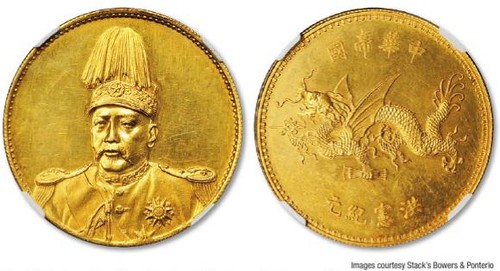
In the February 20 issue of Coin World, there was an article by Ron Gillio, beginning on page 62, concerning some documents from the Philadelphia Mint in his possession. The invoices, on Philadelphia Mint stationery, record that in 1921 the mint made a pair of dies for Philadelphia coin dealer, Henry Chapman, and struck 25 gold and 50 silver medals for him from those dies.
The dies were apparently engraved by George Morgan, as his name appears on one of the documents. The medal is described only as "1-1/2 inches [38mm] in diameter portrait of Chinese general -- reverse dragon with inscription." Mr. Gillio claims that the medal Chapman had made was the well known Yuan Shih Kai Flying Dragon Dollar of 1916 (Yeoman 332; Kann 663).
It is well known to collectors of Chinese coins, that the Italian, Luigi Giorgi, then Chief Engraver at the Tientsin Central Mint of China, engraved the dies for the obverse and designed the reverse (in smaller size, for a gold coin) of this coin. In my opinion, the assertion that the Philadelphia Mint would copy the dies for and strike what are essentially counterfeit coins of China, is a slander on the mint and its engraver, George Morgan.
I have looked through the U.S. Mint Reports (online) for 1920, 1921 and 1922 and find that the report simply lumps together in one total all the various dies made for medals each year, without even naming the subjects.
I have looked through The Numismatist, page by page, from 1918 through 1923, and find no mention (even in the club reports) of the actual Chinese coin or the imitation by Chapman. There is no mention of it in Chapman's advertisements in The Numismatist. I do not have access to Chapman auctions for the 1921-1925 period, when he should have been selling whatever Chinese medals he had made, so I do not know if they were distributed in that way.
Does anyone have any insight into this matter? Do records exist of individual medals made at the U.S. mint in the 1920's? Are Chapman's papers or perhaps a diary preserved somewhere? Would the Philadelphia Mint really make copies of foreign coins or medals? Since he paid for the dies, would Chapman have taken possession of them after the medals were struck, and if so, where would those dies be today?
To read the complete Coin World article, see: editions.amospublishing.com/WDCN/default.aspx?d=20120319
THE BOOK BAZARRE
MORE ON THE FLEA MARKET CONTINENTAL DOLLAR
Ken Berger writes
He bought the coin at a flea market & carried it in his pocket for 40 years (or so he says) & it's slabbed as a MS64! Hmm?
Along similar lines Tom Caldwell writes:
40 years in your pocket & grades MS 64.........great story, but 40 years of rubbing in your pocket & still grades mint state............hmmmm
 Editor's note: After this article was published in the print and digital editions of the March 19 issue of Coin World, the coin was sold twice.
Editor's note: After this article was published in the print and digital editions of the March 19 issue of Coin World, the coin was sold twice.
David G. Carr of Rare Coins of North America LLC, North Reading, Mass., purchased the coin March 2 for "in excess of $120,000." The sale was brokered by John Martin of Martin's Coins and Jewelry.
Carr sold the coin March 6 for an undisclosed price to a collector who has chosen to remain anonymous.
To read the complete Coin World article, see: $1 purchase from 1969 proves windfall (www.coinworld.com/articles/1-purchase-from-1969-proves-windfall/)
To read the earlier E-Sylum article, see: FLEA MARKET FIND STORY: CONTINENTAL DOLLAR IN PEWTER (www.coinbooks.org/esylum_v15n10a18.html)
QUICK QUIZ: WHO ARE THESE 1930S NUMISMATISTS?
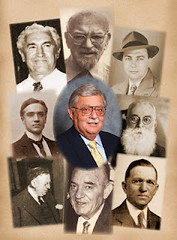 Regarding the image from Stack's Bowers accompanying Harvey Stack's recent reminiscences, Robert Rightmire writes:
Regarding the image from Stack's Bowers accompanying Harvey Stack's recent reminiscences, Robert Rightmire writes:
Can anyone identify each of the individuals pictured in the photo?
Here's a link to the latest installment in Harvey's series: Remember When: A 1970 Gold Story (stacksbowers.com/Blogs/remember-when-1970-gold-story.html)
To read the earlier E-Sylum article, see: THE NEW YORK NUMISMATIC SCENE IN THE 1930S (www.coinbooks.org/esylum_v15n10a13.html)
MANHATTAN BEACH NUMISMATIC CONNECTIONS
Bill Rosenblum writes:
I missed seeing the first reference to the Manhattan Beach Centennial medal but noticed last week's article about it. Manhattan Beach has a fond memory for me as my daughter was married on the beach (3rd Street and the sand) there in 1999 and Jesse Patrick of the Patrick Mint produced tokens to commemorate the event. Unfortunately only the names of the bride and groom and the date are mentioned on the token not the city. But I was there and can vouch for the time and place.
People who know me know I specialize in numismatics related to Jews and Jewish History and a few years later I was at a show (I think it was the New York International) and stopped by Ingrid O'Neil's table. Ingrid usually has a few items of interest and when I asked her if she had anything up my alley she said, "Oh I have this token, do you know who this is?" Of course it was my daughter's wedding token. Since I still have several hundred I decided to pass on it.
It also has a real numismatic connections. Large Cent dealer Doug Bird has a Manhattan Beach PO Box address and a number of years ago when I was in Southern California for a Long Beach show I was walking along one of running and walking paths and I met Bill Noyes, who was probably visiting Doug, jogging my way. Bill and I may have talked numismatics but more likely we traded baseball insults, he's a Red Sox fan and I'm a Yankee fan. Manhattan Beach is one of the ultimate beach towns in America and for those of us who live in land-locked and/or cold places in North America it's a great place to visit in the winter.
To read the earlier E-Sylum article, see: NOTES FROM E-SYLUM READERS: MARCH 4, 2012 / Manhattan Beach Centennial Medals (www.coinbooks.org/esylum_v15n10a10.html)
THE 1933 DOUBLE EAGLE WORLD TOUR MOVES TO IRELAND
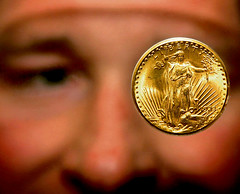 This is the first time that a double eagle has gone on display in Europe. The exhibition has been arranged by the Samlerhuerst Group in association with the Smithsonian Institute.
This is the first time that a double eagle has gone on display in Europe. The exhibition has been arranged by the Samlerhuerst Group in association with the Smithsonian Institute.
"We believe that it is important for us to take iconic rocks or objects like this on the road and share them with people," said Karen Lee of the Smithsonian Institute.
We want to engage people in learning history from objects.
The 1933 double eagle is on display along with a collection of other US coins at the Baroque Chapel at the Royal Hospital Kilmainham.
To read the complete article, see: Golden opportunity: World's most expensive coin goes on show (www.irishtimes.com/newspaper/ireland/2012/0307/1224312919094.html)
It was designed by Augustus Saint-Gaudens, who was born in Ireland, and based on an ancient sculpture called 'The Crouching Venus'.
The designer, whose mother was Irish, died before he had an opportunity to see the finished product.
To read the complete article, see:
Lucky 'double eagle' coin lands in Ireland
(www.independent.ie/national-news/lucky-double-eagle-coin-land
s-in-ireland-3041664.html)
To read the earlier E-Sylum article, see: THE 1933 DOUBLE EAGLE WORLD TOUR OPENS IN LONDON (www.coinbooks.org/esylum_v15n10a22.html)
PAKISTANI GROUPS COUNTERFEITING INDIAN BANKNOTES
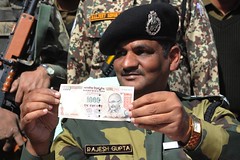 Of all the threats that India tries to keep from spilling across its borders, one has been particularly difficult to block: fake Indian rupees printed in Pakistan.
Of all the threats that India tries to keep from spilling across its borders, one has been particularly difficult to block: fake Indian rupees printed in Pakistan.
Bank transactions involving counterfeit currency increased 400 percent in the past year, according to India's Finance Ministry, and officials in the capital made a record seizure of fake cash during a search of fabric shipments from Pakistan this year.
Officials say Pakistani groups produce the high-quality fake notes and use them to fund terrorism and drug networks in India. Counterfeiting is also a form of economic sabotage, the officials say, that could deter global investors if left unchecked.
The high quality of the notes indicates that sophisticated machines are used to make them, the officials say, adding that such equipment is available only to governments. The fakes typically have security features found in genuine notes, such as watermarks, silver security threads and micro-lettering, intelligence reports say.
Under Indian law, carrying and using counterfeit currency is punishable by up to seven years in prison. But security officials are now debating a proposal that would make currency counterfeiting an offense related to terrorism that could carry a life sentence.
Counterfeit currency is smuggled into India along with weapons or drugs, or is hidden in legitimate cross-border trade, officials say. In the New Delhi seizure, for example, police found about $460,000 in fake money in a search of two truckloads of fabric from Pakistan. The notes were hidden in cardboard boxes that the fabric was wrapped around, police said.
To read the complete article, see:
India faces flood of counterfeit cash from Pakistan
(www.washingtonpost.com/world/asia_pacific/india-cracks
-down-on-counterfeit-cash/2012/02/24/gIQA3T0DuR_story.html)
THE BOOK BAZARRE
QUERY: BRONX COIN CLUB MEDAL INFORMATION SOUGHT
Bill Marquis of Plattsburgh,NY writes:
Do you have a contact for anyone who might know about Bronx Coin Club Medals? I have two of them, a 1941 & a 1948. I hear they are quite rare. Is there anything written about them? I hear there may also be ones issued in 1933, 1937, 1938, 1950, 1974 and perhaps other years.
NAPOLEON III, THE FRENCH VAMPIRE

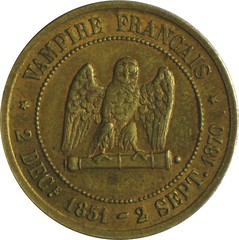
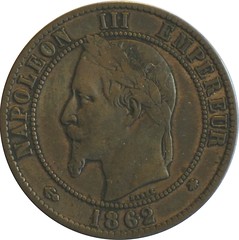

Some numismatic items scream to be acquired. A few years ago, I saw a piece at Alliance Coins, in Almonte, that did just that, and immediately got it, even though I had no idea what the story behind it was. Simple research revealed the bare facts: it was a satirical medal that used distorted imagery from the circulating coinage, and was issued after the defeat of France in the Franco-Prussian War. The loss was blamed on Emperor Napoleon III, who was captured in the battle of Sedan and deposed days later.
Is this the whole story? Is it just another piece similar to the "Diefenbucks" issued in Canada in the 1960s, after the devaluation of the Canadian dollar? Do we just chuckle and move on?
Deeper research tells another story. In fact, there are many stories. There is the story of the satirical piece, the story of Napoleon III, and the story of the Franco-Prussian War. Of course, all of them are intertwined, and this short article can only touch on them and perhaps whet your appetite to learn more.
For more information about Moneta and the Ottawa Numismatic Society, see: ons-sno.ca
Since January 2012, moneta is the only entirely bilingual (English/French) numismatic publication in North America (before only 30% of the material was also published in French). It won first prize in the Best Local Numismatic Publication of the ANA in 2010.
It is published ten times a year and is distributed electronically. Membership is only 12 CAD. Soon after the publication year ends, a library-quality hardbound book is prepared and published in full colour on 80-lb acid freed paper (letter size). The 2011 edition will have 408 pages.
For more information please contact the Ottawa Numismatic Association's president at president@ons-sno.ca.
PAKISTANI BANKNOTE FOUND IN NEW PAIR OF JEANS
 Schoolboy Oliver Mawson- Lewis got an unexpected bonus when he put on his new pair of jeans.
Schoolboy Oliver Mawson- Lewis got an unexpected bonus when he put on his new pair of jeans.
The 10-year-old from Prestbury discovered a Pakistani bank note in one of the pockets. When his parents looked at the label in the item bought in the Cheltenham Matalan store, they saw the jeans were made in Pakistan.
Dad Tim said: "The note was folded in half in the jeans pocket and is quite well worn. We were so surprised to find it and didn't know whether it was a practical joke at first.
"The 20 Rupee note must have been placed there when the jeans were made in Pakistan, but the reason remains a mystery."
Ollie, a pupil at St Mary's Junior School who is keeping the note as a souvenir, said: "I was a bit disappointed when my dad looked up the exchange rate and found the note was only worth around 15p."
To read the complete article, see:
Bank note surprise in boy's jeans
(www.thisisgloucestershire.co.uk/Bank-note-surprise-boy
-s-jeans/story-15455751-detail/story.html)
HOW A BELLY DANCER FLIPS COINS
Kavan Ratnatunga writes:
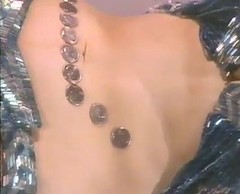 Helena Vlahos is a well known belly dancer and in the Guinness Book of World Records for "Unique Abdominal Dexterity". Helena is also the recipient of MECDA's Lifetime Achievement Award 2011 and was nominated for Favourite Cabaret or Oriental Dancer.
Helena Vlahos is a well known belly dancer and in the Guinness Book of World Records for "Unique Abdominal Dexterity". Helena is also the recipient of MECDA's Lifetime Achievement Award 2011 and was nominated for Favourite Cabaret or Oriental Dancer.
She has the ability to roll nine quarters on her belly and a dollar bill. Here is that amazing video where the American belly dancer Helena showing belly tricks. I have never been so mesmerized by someone flipping coins.
To watch the complete video, see: Guinness belly trick (www.youtube.com/watch?feature=player_embedded&v=Yik7c0EXV0M)
FEATURED WEB PAGE: LE MONETE SATIRICHE
This week's Featured Web Page is Le Monete Satiriche (Satirical Coins). It's mostly in Italian, but it's readable and has some great images. QUICK QUIZ: Who can tell us more about the pictured medal?
This is a small coin and medal excursion dealing with satire, and written upon the request of friends. I have divided, according to my idea of it, coins and medals into five principal groups.
a) The most recent issues ( modern ).
b) Coins transformed with the graving tool.
c) Issues deriving from coins or medals relating to:
the defeat of Napoleon III° and his defeat at Sedan, Admiral Howe,
to Napoleon I°, to Maria Theresa of Austria, to the medallist Christian Vermuth and to many others from 1550 onwards.
d) Satiric medals of particular value, produced during the British Restoration period of the sixteenth and seventeenth centuries. Most attractive and sought after are the historical medals relating to the strangled lawyer Edmund Godfrey.
e) The medals of a great artist, Karl Goetz, with numerous examples relating to WW1 and WW2.
A few rare exceptions aside, satiric coins of ancient Rome and Greece are unknown.
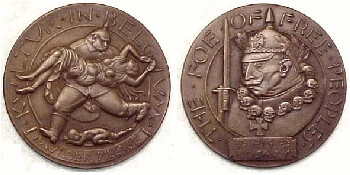
www.roth37.it/COINS/Satirical
